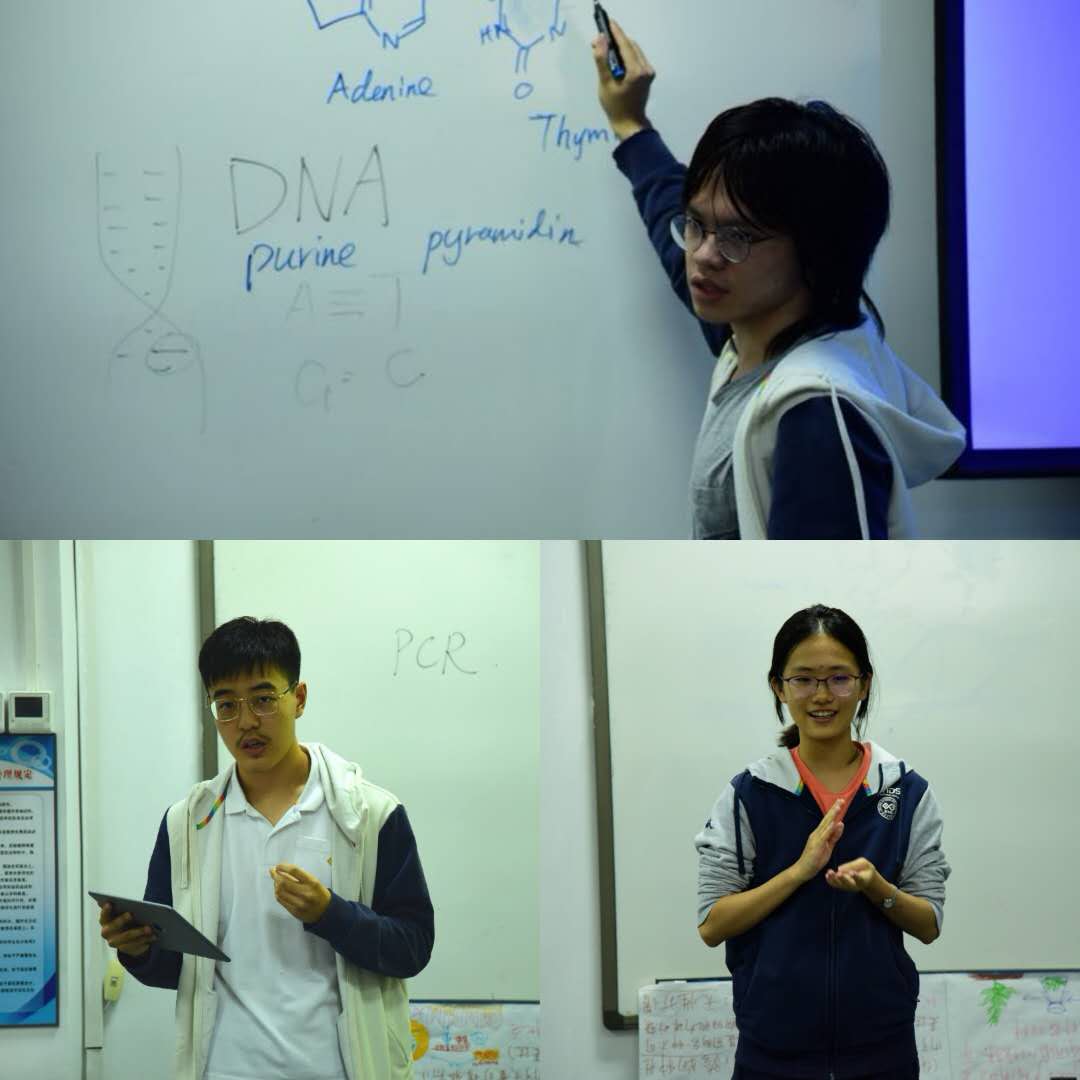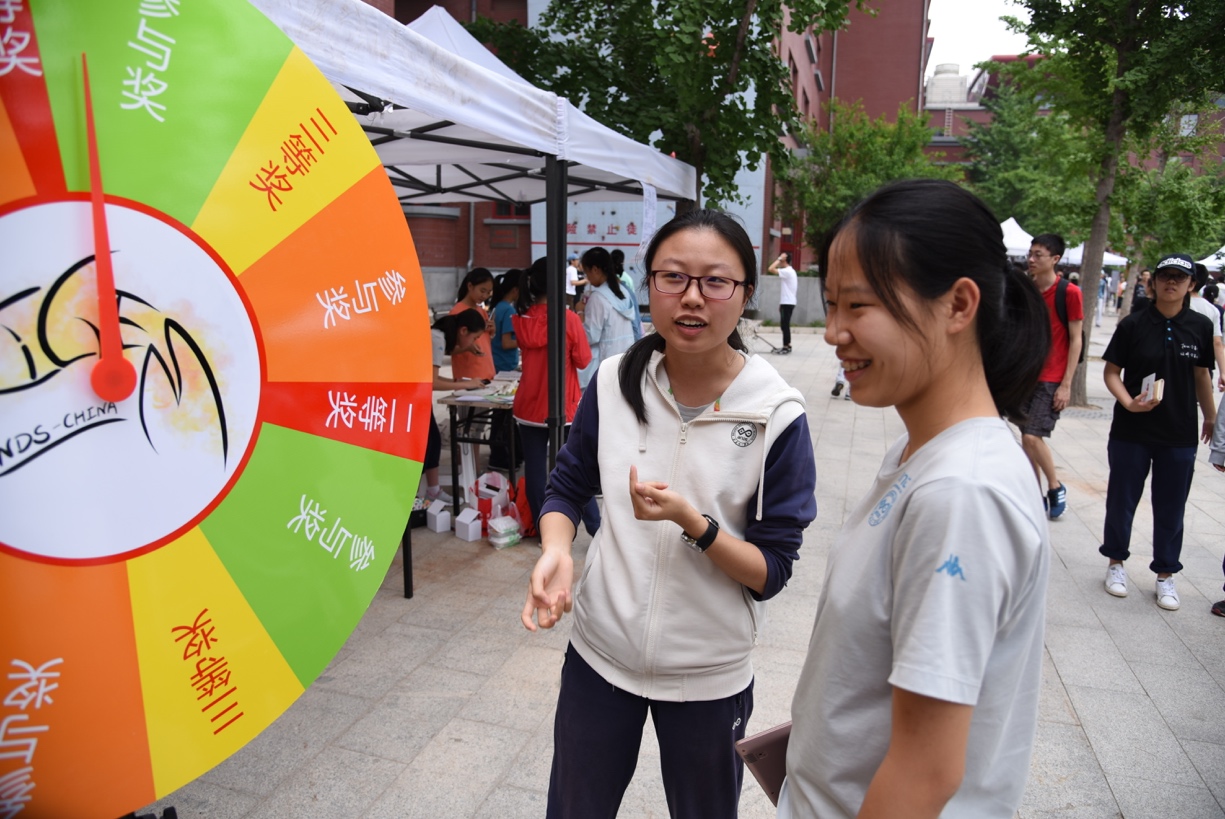We have designed and conducted several activities for our human practice to discover the current field of
antibiotics towards common marine pathogens and to spread the idea of our project to our peers. For gold human
practice, we visited a fish farming industry in Beijing to learn common diseases in fishes and general methods
of treatment and prevention. We also visited the largest fish trade market in Beijing to get to know the
methods of preservation of fishes and published booklets for the methods. For the public engagement and
education, we managed to take a hand in the annual trading fair of our school. We sold our products which
include knowledge from synthetic biology, aiming to burst interest of synthetic biology in our schoolmates.
Also, as we founded an iGEM club in our school last year, we continued our activity by giving another free
public lecture to students, aiming to popularize synthetic biology in our school.Human Practice
-Gold Human Practice
I. Fish farming industry visit

We visited Shuntong fish farming center (one of the largest fish farming industry in China) in Beijing. The manager of the center told us that there have been outbreaks of diseases in the past years, and the common treatment is drug distribution. The symptoms include body hemorrhage, and it gets more serious when the water in the pool is unclean. Based on the manager’s description, we deduced that it was A. hydrophila that’s causing the outbreaks. We also learned other common types of fish disease and how they are caused by different pathogens.
Moreover, we suggested our treatment which is using our genetically modified E. coli. Although further experiments are still needed before our treatment can actually be introduced to the fish farming industry, the manager had great expectations on us. She was hoping that the development of our technology could eventually bring the revolution to the whole fish farming industry. However, she had concerns with the safety issues with our project, since GMO often sounded dangerous in China.
Thus, from this visit, we were encouraged to develop A. hydrophila killer to protect the health of fishes. In addition, we set up two goals for our human practice: 1). Promote efficient methods for preserving fish health; 2). Promote synthetic biology through public engagement and education.
II. Fish trading market visit

To fulfill the first goal of our human practice, we also visited a fish trading market, which was one of the largest fish trading markets in Beijing, near our school. This market only sold fish as pet, and we asked them about some common preservation methods of fish. The answer was the clean water and enough food source, while clean water is at the higher priority. Through this visit, we learned more about the current field of fish preservation and disease prevention, helping us further understand the significance of our project.
After this visit, we summarized the tips for preserving the health of aquarium fishes, and published a booklet for these tips. We printed hundreds of booklets and distributed them to the fish trading market. The sellers were excited to see the booklets and they gave them to their customers.
Public Engagement
I. Public lecture

Establishing club is an efficient way to share the knowledge and find the people who share the same interest. This year, we continued the school club we established last year, and presented a synthetic biology lecture at school.
Our goal was to popularize the synthetic biology to the students in our school. Since lots of people had a misunderstanding towards synthetic biology, we really wanted to clear it up. Therefore, we designed an interesting lecture to achieve this goal. We deeply understood that lots of students on our campus didn’t have enough knowledge of even basic biology and they would feel bored if we teach them for a whole class period. In order to avoid such a situation, we were well-prepared beforehand. We divided our lecture into three parts. The first part was a brief introduction of synthetic biology. We made a short video to clarify what synthetic biology is and its applications in the real world. What's more, we also emphasized the core of synthetic biology: modularization and standardization.


The students' stereotypical viewpoints toward synthetic biology were revolutionized by our lecture.
The second part was the introduction of the typical genetic engineering process and some basic information about genetic biology, including DNA structure, transciption & translation, PCR, etc. We wanted our club members to understand how the basics of biology can be applied in synthetic biology.
Finally, since putting the knowledge into practice was really important, we designed a DNA extraction experiment. We used salts and detergent to break the cell membranes of bananas. Then, to increase the surface area of cells, we mashed the banana. We used a strainer to filter the banana puree and gained the solution contained DNA. Finally, by adding up alcohol, the DNA precipitated at the bottom of the cup. This process of extraction is known as ethanol precipitation. The students enjoyed the experiment a lot and they gained interests to synthetic biology as well as iGEM competition.
III. Red Window Expo
The Red Window Expo is our school’s traditional activity. At the expo, students get an opportunity to show their versatile talents and sell their self-developed products. Moreover, student organizations can display their marvelous ideas and propagate their projects in the expo. This activity aims to nurture students’ individuality, inspire creativity, facilitate the interaction between different grades and enrich the campus culture.
It was a tradition for our team to promote our project in the Red Window Expo. To draw students attention while incorporating the idea of synthetic biology into the activity, our team ingeniously designed a series of engaging yet informative activities to promote synthetic biology and our project on campus. We made various types of bookmarks with delicate illustrations and some related definitions of synthetic biology on them. We also made a huge amount of palatable fortune cookies that contained a variety of biology questions. Only students who correctly answered the questions had access to the “Wheel of Fortune” and the opportunity to win special gifts. Besides, while organizing the activities, our teammates introduced our project and the knowledge of synthetic biology to the participants.
Our project drew tons of attention in the expo and was a huge success. A huge number of students visited our stall and engaged in the colorful activities about synthetic biology. Students dabbled in the field of genetic engineering and appreciated the wisdom of biology with the lead of these activities. The expo also helped us to popularize iGEM in our school. Some students even expressed keen interests in taking part in the competition next year. Meanwhile, the biology teachers in our school provided us with a variety of fundamental suggestions such as the design of the experiment and the application of our genetically engineered machine, which were stepping stones to our final project.

Feelings from team members:
During the Red Window Expo, we sale our DIY book marks with the knowledge about cell organelles and cookies on the Red Window Expo. All the teachers and students were in an exciting and enjoyable atmosphere. It was highly inspiring when watching our customers who tried hard to answer the questions we made, bought our bookmarks, and ate the cookies. This was a fantastic experience.
- By Levant Yan
This was my first time to be fully engaged in the Red Window Expo. I was in charge of designing, ordering, and selling fortune cookies. I was amazed by students' passion in biology and was happy to see that students managed to answer most of our questions about genetic engineering. I hope that more and more students will be interested in joining BNDS iGEM team next year!
- By Mackie Zhou
